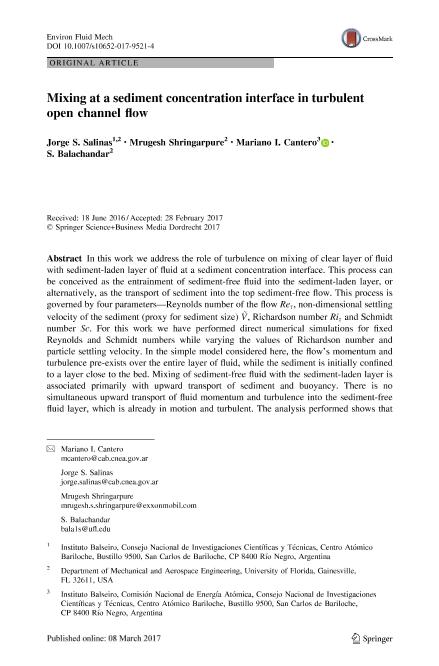Mostrar el registro sencillo del ítem
dc.contributor.author
Salinas, Jorge Sebastián

dc.contributor.author
Shringarpure, Mrugesh
dc.contributor.author
Cantero, Mariano Ignacio

dc.contributor.author
Balachandar, S.
dc.date.available
2018-09-04T15:43:07Z
dc.date.issued
2018-02
dc.identifier.citation
Salinas, Jorge Sebastián; Shringarpure, Mrugesh; Cantero, Mariano Ignacio; Balachandar, S.; Mixing at a sediment concentration interface in turbulent open channel flow; Springer; Environmental Fluid Mechanics; 18; 1; 2-2018; 173-200
dc.identifier.issn
1567-7419
dc.identifier.uri
http://hdl.handle.net/11336/58225
dc.description.abstract
In this work we address the role of turbulence on mixing of clear layer of fluid with sediment-laden layer of fluid at a sediment concentration interface. This process can be conceived as the entrainment of sediment-free fluid into the sediment-laden layer, or alternatively, as the transport of sediment into the top sediment-free flow. This process is governed by four parameters—Reynolds number of the flow Reτ, non-dimensional settling velocity of the sediment (proxy for sediment size) V~ , Richardson number Riτ and Schmidt number Sc. For this work we have performed direct numerical simulations for fixed Reynolds and Schmidt numbers while varying the values of Richardson number and particle settling velocity. In the simple model considered here, the flow’s momentum and turbulence pre-exists over the entire layer of fluid, while the sediment is initially confined to a layer close to the bed. Mixing of sediment-free fluid with the sediment-laden layer is associated primarily with upward transport of sediment and buoyancy. There is no simultaneous upward transport of fluid momentum and turbulence into the sediment-free fluid layer, which is already in motion and turbulent. The analysis performed shows that the ability of the flow to transport a given sediment size decreases with the distance from the bottom, and thus only fine enough sediment particles are transported across the sediment concentration interface. For these cases, the concentration profiles evolve to a final steady state in good agreement with the well-known Rouse profile. The approach towards the Rouse profile happens through a transient self-similar state. This behavior of the flow is not seen for larger particles. Detailed analysis of the three dimensional structure of the sediment concentration interface shows the mechanisms by which sediment particles are lifted up by tongues of sediment-laden fluid with positive correlation between vertical velocity and sediment concentration. Finally, the mixing ability of the flow is addressed by monitoring the time evolution of the center of mass of the sediment-laden layer and the vertical location of the sediment-free/sediment-laden interface.
dc.format
application/pdf
dc.language.iso
eng
dc.publisher
Springer

dc.rights
info:eu-repo/semantics/openAccess
dc.rights.uri
https://creativecommons.org/licenses/by-nc-sa/2.5/ar/
dc.subject
Direct Numerical Simulation
dc.subject
Gravity Current
dc.subject
Mixing
dc.subject
Sediments
dc.subject
Turbidity Current
dc.subject
Turbulence
dc.subject.classification
Ingeniería Mecánica

dc.subject.classification
Ingeniería Mecánica

dc.subject.classification
INGENIERÍAS Y TECNOLOGÍAS

dc.title
Mixing at a sediment concentration interface in turbulent open channel flow
dc.type
info:eu-repo/semantics/article
dc.type
info:ar-repo/semantics/artículo
dc.type
info:eu-repo/semantics/publishedVersion
dc.date.updated
2018-09-03T20:09:45Z
dc.identifier.eissn
1573-1510
dc.journal.volume
18
dc.journal.number
1
dc.journal.pagination
173-200
dc.journal.pais
Alemania

dc.description.fil
Fil: Salinas, Jorge Sebastián. University of Florida; Estados Unidos. Comisión Nacional de Energía Atómica. Gerencia del Área de Energía Nuclear. Instituto Balseiro; Argentina. Comisión Nacional de Energía Atómica. Centro Atómico Bariloche; Argentina. Consejo Nacional de Investigaciones Científicas y Técnicas; Argentina
dc.description.fil
Fil: Shringarpure, Mrugesh. University of Florida; Estados Unidos
dc.description.fil
Fil: Cantero, Mariano Ignacio. Comisión Nacional de Energía Atómica. Gerencia del Área de Energía Nuclear. Instituto Balseiro; Argentina. Comisión Nacional de Energía Atómica. Centro Atómico Bariloche; Argentina. Consejo Nacional de Investigaciones Científicas y Técnicas; Argentina
dc.description.fil
Fil: Balachandar, S.. University of Florida; Estados Unidos
dc.journal.title
Environmental Fluid Mechanics

dc.relation.alternativeid
info:eu-repo/semantics/altIdentifier/doi/http://dx.doi.org/10.1007/s10652-017-9521-4
dc.relation.alternativeid
info:eu-repo/semantics/altIdentifier/url/https://link.springer.com/article/10.1007%2Fs10652-017-9521-4
Archivos asociados
